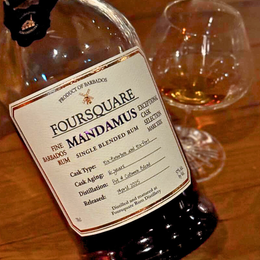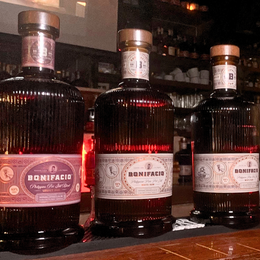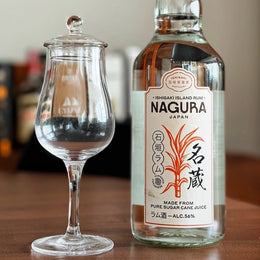
During a recent masterclass with Phil Thompson of the Dornoch Distillery/Thompson Bros IB, I got to try a nice expression from the 1997 vintage of Caroni rums. Unfortunately, I wasn't able to take a photo of the bottle during the masterclass - it was quite bustling, with many folks walking around and talking. For reference, it is the one most right in the photograph - most conspicuously labelled with a giant squid.
During the session, most were eyeing the 30 Year Old Islay, an unnamed Laphroaig, which should already quickly inform you of the demographic's preference - there are substantially more whisky fans than rum maniacs in Singapore. Although it must be said that the rum folks that do exist - and I can confirm they do, as I myself am one - are a highly passionate bunch.


Phil Thompson - what a treat!
Quite frankly, I myself was looking forward to the Caroni, and then also the Dornoch's own whisky, which comes from the Thompson Bros who use their indie bottling business to support their own whiskymaking.
I'm going to jump right out and say that Asian culture is one that deeply loves comfort and the familiar, people here don't typically fashion themselves as wildcards and that goes likewise for their taste and preference. In terms of clothing choice, most folks would go with the safer, more moderate bet, and in terms of choice of drink, what is most popular. As such, it had to be the Laphroaig, which is of course, much more well-known and has a longer, more sterling and transparent track record.

This was the crowd favorite, which should inform you of the demographic at hand.
And then there's also the love for quantitative measures - it's a far easier mental heuristic to deciding what to choose and which is "better". Again, 2 for 2 - it had to be the 30 Year Old Laphroaig.
That meant that you had a wonderfully well-aged Caroni that pretty much flew under the radar, with little appreciation for its craft or rarity, and much less any recognition for its clout amidst rum circles. For most in Asia, Caroni has even less weight than if you said "Macaroni" - yes, the tubular pasta. The rum category is far too opaque and difficult to understand and that level of uncertainty for the price is a big no-no.

The defunct distillery's best days unfortunately occured after its closure. (Image Source: The Whisky Exchange)
Anyway, I haven't much talked about Caroni's, which of course the Internet is littered with information about the now defunct Trinidadian distillery. I'll take this opportunity to just cover some of the groundwork for my own posterity's sake.
Caroni has existed for over a century, and was at one point a key player in Trinidad's sugar market. Eventually, as with a number of Caribbean rums, it made its way into the British Navy rations and had belonged to a British firm named Tate & Lyle (which you might know from the sugar substitute Splenda, for which they produce its key ingredient sucralose). In classic boom and bust fashion, the Trinidadian sugar industry began to decline in the 1960s when Trinidad gained independence from the British and was imposed upon a price cap for sugar. This made the sugar trade no longer attractive and so the controlling stake in Caroni was sold back to the local government, which now had to self-govern. It was fully nationalised by 1975.

The distillery at its peak was responsible for almost 35% of the country's employment and as such its closure had more than just an impact on the rum community but actually had a huge economic impact. (Image Source: French Connections LMDW)
The distillery itself was apparently quite popular with locals but as a business continued to lose money for the next two-plus decades. This forced the government to retreat from its ownership due to the onerous financial burden it wrought. The distillery was put up for auction, and there's some debate as to what exactly went down, with some sources saying that fellow Trinidadian distillery Angostura was the preferred bidder. However, a dispute over the value of Caroni's some 18,000 barrels of rum resulted in there being no final buyer, leaving the distillery to eventually be shuttered as the both sugar and rum production had become unprofitable at that point.
Today, Angostura is the only surviving distillery (of at one point, 48 distilleries across Trinidad) that still operates. Of the 48 distilleries that once existed, Caroni stands out not simply because of the quality of their rums, but that at its peak, it was responsible for about 35% of the island's workforce. And while you might think this only concerns rum, in fact, this was at the center of big political scandal and actually had a huge economic impact on Trinidad and till today is apparently quite a taboo topic in the country.

Angostura, perhaps more well known for their bitters that is widely used in cocktails, ultimately proved to be the sole survivor of the Trinidadian rum complex. (Image Source: Angostura)
While the distillery itself was no more, its rum stocks still went up for sale, with most of the stock going to Angostura. Yet in the mid-2000's, Italian importer Velier and UK bottler, Bristol Spirits, were able to broker a sale resulting in their acquisition of a substantial proportion of Caroni stock. Working the Velier magic, its chief Luca Gargano marketed the hell out of it and eventually brought the defunct Trinidadian distillery's fame to new heights.

Caroni was able to produce heavier styled rums despite using a column still which remains something quite remarkable about the distillery. (Image Source: Fredi Marcarini; Barrel Aged Thoughts)
The Caroni Distillery itself is also quite the unique beast - while it is mostly known for its heavy-style rums; oily, dirty, heavy-bodied, intensely flavorful diesel, sweet, fruity notes, it was able to produce this style of rums using a column still. Such heavier styles are typically associated with pot stills which are able to produce more congeners (the flavorful stuff) at the expense of production efficiency. Yet, Caroni defied such conventional wisdom and found a way to time their distillation cuts (the points at which they drew out spirit from the stills ready for consumption) to produce heavier-styled rums, known as the Heavy Type Rums/Heavy Trinidad Rum (HTR) mark. The distillery also produced a second less popular but in my opinion no less high quality style known at the Light Type Rums/Light Trinidad Rum (LTR). For the sake of simplicity, you could think of the HTRs as having contained more congeners, while LTRs typically contained less, and so were often considered less flavorful.
Now that I've detailed some of Caroni's backstory, something that is quite the peculiarity and which today's bottle allows me the chance to touch upon is the specific 1997 vintage of Caroni rums.

Several vintages are missing from Velier's lineup, with the 1997 vintage one that interestingly is simultaneously prevalent across other bottlers but decidedly absent from the Genovese distributor's stable. (Image Source: Le Blog A Roger)
As mentioned earlier, most of Caroni's remaining stock upon the distillery's closure had gone to Angostura, Bristol and Velier, the latter two of the trio had bottled Caroni's of vintages anywhere from 1974 to 2000, when the distillery had stopped production (though there are rumors that there were bits of production even up till 2002). The most well-understood era of Caroni's then had to be the 1990s which forms the bulk of the Trinidadian concern's releases from the two bottlers, and as such had the most sip-time with drinkers. And yet if you parse through Velier's releases, you'd find a couple of missing vintages from the 90's - 1995, 1997 and 1999.

The Thompson Bros takes on Caroni!
As it so happens, the 1997 vintage is one of the most diversely bottled of Caroni's 1990's stock. It stands as one of the deepest vintages from Caroni and yet not one belongs to Velier (and only a few has been released under Bristol). The hypothesis out in the back alleyways of the Internet is that the 1997 vintage was primarily sold to other big European bottlers such as The Main Rum Company and E & A Scheer, which was aged continentally in Europe and later sold to various independent bottlers. As such, there weren't any aged stock of 1997 Caroni's left up for grabs when Velier had come knocking on the shuttered distillery's walled up doors year later.
As such, if you'll notice that most Caroni IBs especially those featuring vintages from the 90's would happen to be the 1997 vintage. Now if you were looking to try that specific vintage - 1997, you'd have to look beyond Velier, which opens up a whole wide colorful world of IB bottlers who have the 1997 canvas to showcase their interpretation of the shuttered Trinidadian distillery's rums. That makes the 1997 one of the most fun (and somewhat considered to be the most consistently good quality) vintages to explore as there is so much diversity with no overpowering dominance from the two big bottlers.
Now that we've done our homework, we can get to the tasting!

Caroni 1997 Thompson Brothers 20 Years Old, 61.9% ABV - Review
Color: Deep Amber
Aroma: That classic Caroni richness, but alot brighter and more uplifting here than we're used to - the standard issue tarry diesel notes are much more restrained here to more of an aromatic whiff. This leans more towards the treacle, brown sugar, burnt caramel profile, sweeter, more decadent, more approachable. This continues to open up into milk chocolates, candied fruit, apple brandy, apricots, mangoes, figs, cherries, plums and nectarines, all coated in honey, with just a touch of balsamic.

Don't worry though, the Caroni DNA is still very much present but as mentioned, more aromatic and fragrant and less synthetic. Dried rosemary, essential oils, tyre grease, rubber tubing - it's there alright, but sans the bite and prickle. There's a good heap of old wood, lacquer, a little bit of walnut oil, and then a more herbaceous note of mint jelly and rosemary in olive oil.
Taste: There's just the faintest of acidity that makes its mark as a very noticeable but quickly vanishing bite, and then it quickly blooms into a fruit salad of tinned mangoes, blackberries, kiwis, strawberries, mandarin oranges all soaked in honey syrup. Very sweet and estery, with a great mouthfeel, thick and syrupy.

This sweetness is punctuated with more squeaky fusel oil notes, licorice, candied ginger, olive tapenade, burnt ends, espresso grounds - the classic umami bittersweetness. There's a more pronounced oaky tannic astringency here, but it is ultimately overpowered by the tinned fruits and honey.

Finish: Clean, mid-length, and leans more towards caramel, vanilla and oak. Just a touch of mint jelly and some light white florals. The slightest medicinal note you'd find in an Islay whisky named Laphroaig.
My Thoughts
This was just downright enjoyable. I raved about this for several weeks on and found it to be just a great sipper. What struck me was the role reversal where this was much more fruit-forward, with the tarry diesel notes in the backseat. This made it overall super approachable and easy to enjoy, with such affable notes and a well structured body and nice clean finish. The oaky woodiness was a nice touch here as well, bringing in just that bit of astringency that gave it that much more complexity.
My Rating |
🧙♂️One of those movies that starts off with an old wizard setting the protagonist off on a quest that will eventually be 5 sequels long and involve big monsters, losing some friends along the way, and figuring out if one is truly cut out to be the hero. This is the perfect starter Caroni. Sweet, fruity and light umami, this Caroni puts the fruits upfront and the tarry diesel on a leash. |
Sweet, fruity, lightly umami - what's not to like? The perfect starter Caroni.
Kanpai!

@111hotpot







